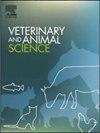石灰基调理剂对不同垫层材料环境乳腺病原菌的防治效果
IF 1.9
Q2 AGRICULTURE, DAIRY & ANIMAL SCIENCE
引用次数: 0
摘要
床褥类型和管理影响细菌生长,潜在地增加奶牛新的乳内感染(IMI)的风险。我们研究了不同浓度的石灰基调节剂(LBC)对新砂、回收粪便固体(RMS)和锯末接种的四种环境乳腺病原体(大肠杆菌、肺炎克雷伯菌、屎肠球菌和ubercoccus)的影响。从商业奶牛场收集垫层基质,消毒后分别接种细菌悬浮液。增加LBC浓度(0%、10%、15%和20%),并在28°C下孵育24、72和168 h,以评估生长动态、干物质含量(DM)和pH。LBC增加了所有层理材料的pH。在砂和RMS中,pH值显著升高,分别达到12.83±0.05和11.72±0.12。在木屑中,当LBC为20%时,pH值的增加幅度较小,为10.91±0.14。沙子表现出对细菌生长的固有抵抗力,10%的LBC完全抑制细菌增殖。未经处理的RMS很容易支持细菌生长,并且需要高LBC浓度。在RMS中,LBC对大肠杆菌和肺炎克雷伯菌的控制优于uberis和E. faium。锯末需要20%的LBC浓度才能有效控制大肠杆菌和肺炎克雷伯菌的生长。粪便E. faecium一般不受LBC的影响,而即使没有添加LBC,木屑中的ubers .生长也受到抑制。因此,LBC成功地减少了乳腺炎病原体负荷,其有效性取决于浓度和底物类型。未来的实际农场应用研究将需要验证这些发现。本文章由计算机程序翻译,如有差异,请以英文原文为准。

Efficacy of lime-based conditioner against environmental udder pathogens in different bedding materials
Bedding type and management influence bacterial growth, potentially increasing the risk of new intramammary infections (IMI) in dairy cows. We investigated the effect of various concentrations of lime-based conditioner (LBC) on four environmental udder pathogens (Escherichia coli, Klebsiella pneumoniae, Enterococcus faecium, and Streptococcus uberis) inoculated into new sand, recycled manure solids (RMS), and sawdust. Bedding substrates were collected from commercial dairy farms, sterilized, and separately inoculated with bacterial suspensions. Increasing concentrations of LBC (0 %, 10 %, 15 %, and 20 %) were applied and samples were incubated for 24, 72, and 168 h at 28 °C to assess growth dynamics, dry matter content (DM), and pH.
LBC increased the pH of all bedding materials. In sand and RMS, pH levels rose substantially, reaching 12.83 ± 0.05 and 11.72 ± 0.12, respectively. In sawdust the pH increase was lower, reaching 10.91 ± 0.14 with 20 % LBC. Sand showed inherent resistance to bacterial growth, with 10 % LBC completely inhibiting bacterial proliferation. Untreated RMS readily supported bacterial growth and required high LBC concentrations. In RMS, LBC controlled E. coli and K. pneumoniae better than S. uberis and E. faecium. Sawdust required LBC concentrations of 20 % to effectively control E. coli and K. pneumoniae growth. E. faecium was generally unaffected by LBC, while S. uberis growth was inhibited in sawdust even without LBC addition. LBC was therefore successful in reducing mastitis pathogen loads, with an effectiveness depending on concentration and substrate type. Future research on practical on-farm applications will be required to validate these findings.
求助全文
通过发布文献求助,成功后即可免费获取论文全文。
去求助
来源期刊

Veterinary and Animal Science
Veterinary-Veterinary (all)
CiteScore
3.50
自引率
0.00%
发文量
43
审稿时长
47 days
 求助内容:
求助内容: 应助结果提醒方式:
应助结果提醒方式:


